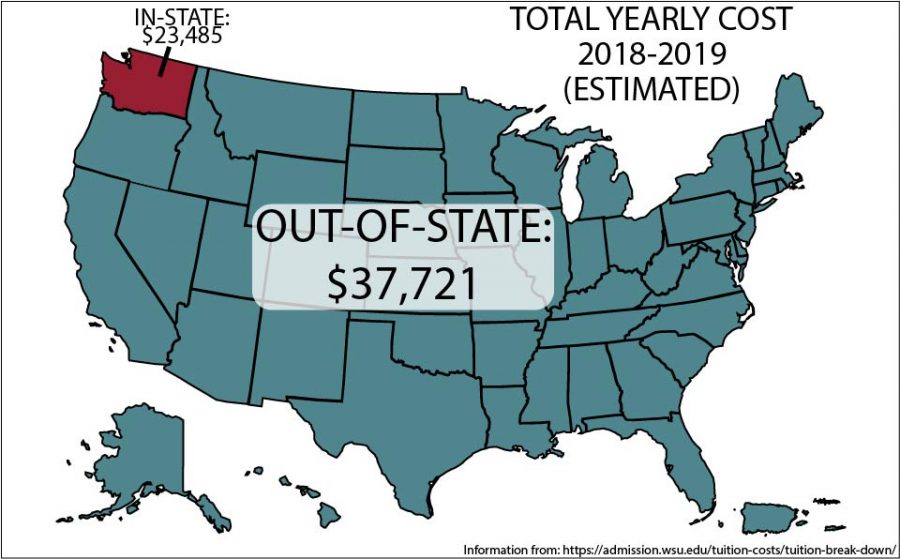Out-of-state students don’t receive enough aid
Washington residents attending WSU have advantage, non-residents require more financial support to succeed
OLIVER MCKENNA | THE DAILY EVERGREEN
Living costs as well as student expenses of WSU scholars coming from outside of Washington leave these individuals with too little. These people should be given more attention by the university, be granted access to more beneficial resources.
January 29, 2019
As one of the more isolated places in Washington, Pullman causes a bit of culture shock to those unfamiliar with the region.
It’s not a threatening area, but when you move away from home, everything is just a little scarier.
Especially when you’re paying more than double per credit hour than in-state students do.
It takes twelve hours to be considered a full-time student at WSU. A normal course load, however, is recommended to be between fifteen or sixteen hours. This can seem quite manageable when a 12-credit course is estimated to cost $856, but out-of-state students pay up to $2,042, according to the WSU tuition page.
“Out-of-state students don’t have access to the same grants that in-state students do,” said Kelly Ngigi, a transfer student ambassador. “If you’re a Pell Grant recipient and you decide to go out of the state that you reside in, you’re not receiving that same funding and that’s for scholarships as well.”
As 15 percent of WSU’s student population comes from out-of-state, there’s a major divide between students attending WSU.
In-state students have such a lower rate of tuition that it’s more practical for them to finish on a four-year plan. Out-of-state students have to figure out what classes they will take as well as what to major in sooner or else face significantly larger costs.
“You have to hit the ground running and that means hit the ground running,” said Ngigi. “From the time you decide you’re coming and not just from the time you arrive on campus.”
As college students, no matter what year, money plays a role. It affects what and when we can eat, whether we can go out to blow off steam or not, and many other situations. When tuition takes up a much more substantial amount of student’s finances, it requires them to stress themselves beyond the schoolwork of a four-year plan.
“[We’re] struggling to just cover [costs] and make ends meet,” Ngigi said. “Whether that be ‘Yes, I do have the money to pay for my tuition, but I don’t have it for my book,’ or ‘I don’t have it to eat or pay rent.’ ”
Scholarships exist and so does financial aid, but these contribute only so much. There are only so many loans and scholarships one can apply for, and none are guaranteed.
At WSU’s orientation dates, students learn a myriad of ways to interact with the campus and become more familiar with services tailored to an array of needs. But, when you are a non-resident, your struggles multiply when no financial solution is made apparent.
“I think the Alive! orientation would be a perfect opportunity to present gaining residency or presenting the most common out-of-state awards,” said Skylar Hamilton, also a transfer student ambassador.
Moving to a different state, especially to start college, is like starting over. However, it is hard to start a new chapter in life when you can barely afford to feed yourself. There isn’t much institutional help when it comes to out-of-state students, and this becomes more apparent when registration begins and bills pile up before you’ve sat in your first lecture.
WSU needs to offer more options for this major part of their student base. Whether this means adding more scholarship opportunities, presenting these options more clearly to students or simply lessening the cost overall, something must be done to lessen the financial burden on these students.








